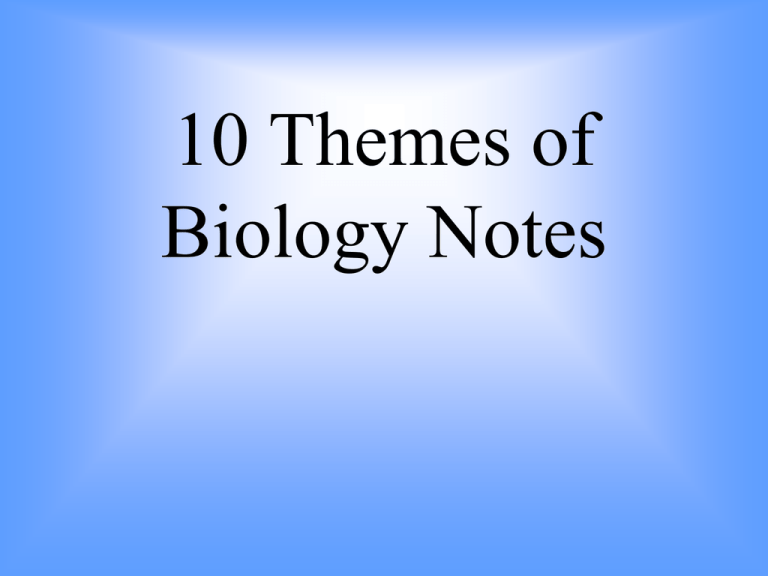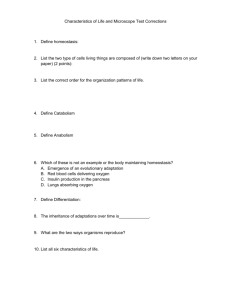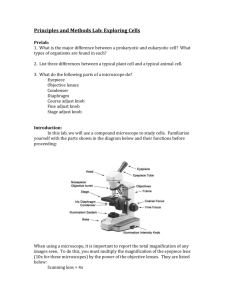notesch1 - RHSBiologyJensen
advertisement

10 Themes of Biology Notes Ten Unifying Themes of Biology 1. Biological Systems – cell, tissue, organ, organ system, organism, population, community, ecosystem, biosphere Cells Tissue Organ Cells working together Tissues working together Organ System Organs working together Organism A living thing 1. Biological Systems – cell, tissue, organ, organ system, organism, population, community, ecosystem, biosphere Biosphere Biome Ecosystem Community Population Organism 2. The Cellular Basis of Life – the cell is the smallest unit of life 3. Form and Function – the shape of things help that organism to do what it is supposed to do (Example: the anteater’s long snout enables it to squeeze in tight places to get food) 4. Reproduction and Inheritance – you inherit similarities from your parents (Example: if nothing else your parents are human and so are you!) 5. Interaction with the Environment – every organism gives off stuff to the environment and every organism takes stuff from the environment (Example: you give off heat and take in food) 6. Energy and Life – Every organism needs energy to live. What happens when an organism runs out of energy? 7. Regulation and Homeostasis – Even though our surroundings are constantly changing our internal environment stays the same. (Example: Body temperature) 8. Adaptation and Evolution – Adaptation is an inherited trait that helps the organism’s ability to survive and reproduce. Evolution is just a change over time. 9. Biology and Society – • How does our society affect life and how does our understanding of biology affect our society? • Cloning, Stem cell research, environmental issues, hunting, medicine, genetically modified crops 10. Scientific Inquiry – Asking questions, using observations or experiments to find possible answers Eyepiece Body Tube Objectives Arm Stage Diaphragm Light Source Coarse Adjustment Fine Adjustment Stage Supports/holds slides High Power Objective Lens with greatest magnification Low Power Objective Lens with lowest magnification Medium Power Objective Lens with medium magnification Eyepiece Where you should look through the lens Light Source Provides light Diaphragm Controls the amount of light on slide Coarse Adjustment Brings object into focus Fine Adjustment Fines tunes object once it is focused Calculating Magnification To calculate the total magnification of a microscope you multiply the magnification of the eyepiece by the magnification of the objective. Example: If a microscope has an eyepiece magnification of 20x and an objective magnification of 50x the total magnification of that microscope is 1000x. If a microscope has an eyepiece magnification of 10x and an objective magnification of 25x the total magnification of that microscope is __________. 250x Microscope Movement When you move a slide on a microscope to the left, the specimen appears to move toward the right when viewed under the microscope. If you move the specimen up it will appear to move down under the microscope. All movements under the microscope are opposite. Why does the opposite movement happen? Microscope Field of View When you switch from low power to high power a couple of things happen. 1. Your object will be more magnified 2. Your object will need to be focused (use the fine adjustment knob only!) 3. Your field of view will be smaller Low Power High Power




